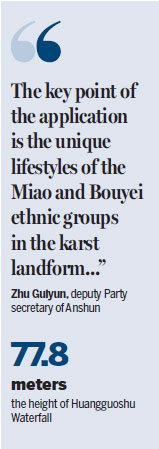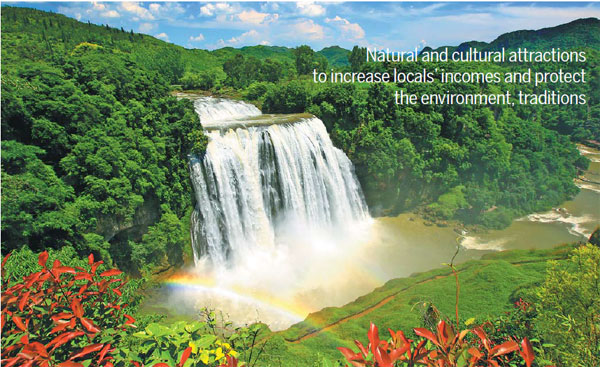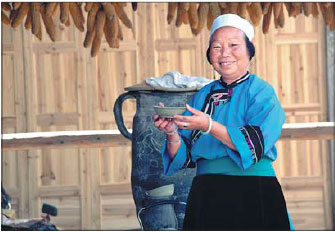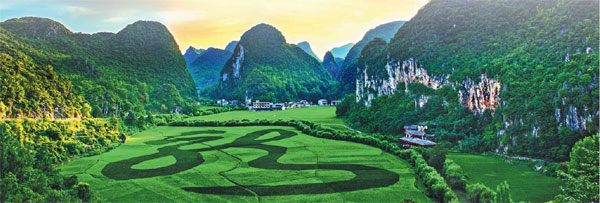Waterfall aims for recognition as UNESCO World Heritage site
Natural and cultural attractions to increase locals' incomes and protect the environment, traditions
Huangguoshu Waterfall, located in the Huangguoshu-Tunpu landscape cluster in the city of Anshun in Guizhou province, is known as the greatest waterfall in China.
The local government is currently submitting a bid to UNESCO for the area's nomination as a World Natural and Cultural Heritage site.
Huangguoshu Waterfall is 77.8 meters high and 101 meters wide. It can be viewed from all angles, even from behind the waterfall itself.
The arching rainbow above the pool adds splendid colors to the pure waterscape.

The main body of the waterfall is 67 meters high and 83.3 meters wide. Surrounding the main waterfall are 18 smaller but beautiful waterfalls, including Luositan Waterfall, Silver-Chain Waterfall and Dishuitan Waterfall, making up the Huangguoshu Waterfalls Cluster, spanning more than 100 square kilometers.
It took 100,000 to 500,000 years for such awe-inspiring scenery to develop. It is typical of the karst landform, in which the waterfall is formed by the dissolution of soluble rocks.
Known as the Kingdom of Karst, the formation of the waterfall is characterized by underground drainage systems with sinkholes and caves.
During the erosion process of the rivers, the water constantly infiltrated and corroded the waterbed, resulting in the current majestic waterfall and the deep steep gorges.
Beyond its extraordinary natural scenery and unique landform characteristics, the scenery district of Huangguoshu-Tunpu also comprises anthropological and cultural heritage dating back to the 14th century.
The ancient villages, bridges and military barracks scattered around the Huangguoshu region have kept their original appearances.
The carvings, ritual sites and daily defense systems are wellpreserved, showcasing the lifestyle of the Bouyei ethnic groups inhabiting Guizhou province over the past 600 years. Apart from the Huangguoshu Waterfall, the Huangguoshu-Tunpu landscape cluster also covers the Getu River landscape, according to Xiong Kangning, a professor at Guizhou Normal University.
The Getu River landscape embodies the ancient communities built up by the Miao ethnic group under the natural conditions of special karst landforms.
Their traditions of living in caves, cave burial culture and rock climbing are the living encyclopedia of residents' interactive daily life with nature.
The Getu River has the largest-capacity caves in the world. Its precipitous canyons and caves showcase the characteristics of the karst landform.
"The Huangguoshu-Tunpu landscape cluster retained the integrated image of ancient Jianghuai culture, the cultures of the Miao and Bouyei ethnic groups, which is an outstanding creation of different streams of traditional human cultures in the karst area.
"It provides important evidence for the study of traditional cultures, ancient architecture and lifestyles in the area," Xiong said. In the 1990s, when the Huangguoshu waterfall scenery area first applied for World Natural Heritage site status, the application was unsuccessful because the surrounding buildings and low forest coverage rate of Banbian Street disrupted the natural scenery.
At present, the local government has restarted the application plan after reconstructing Banbian Street and recovering the forest.
In July 2014, a special conference was held by the provincial government to discuss the application for Huangguoshu-Tunpu landscape's nomination as a World Natural and Cultural Heritage site.
After one month, the local government organized a working group to focus on the application. Thereafter, a comprehensive plan was formed with oversight from all levels of government.
"The key point of the application is the unique lifestyles of the Miao and Bouyei ethnic groups in the karst landform, Tunbao culture and architecture, the Miao ethnic traditions of living in caves, as well as water conservation projects in Baotun village," said Zhu Guiyun, deputy Party secretary of Anshun city.
There are plenty of examples in karst regions showcasing the interactions of human and nature. Although human activities can result in rocky desertification under some extreme conditions, some regions have achieved balance through interaction and have evolved into unique cultural scenery, according to Paul Williams, professor at the department of geography and environmental science at the University of Auckland, New Zealand.
As part of the next step of the application, the local government is establishing the scientific research and monitoring of the history and culture of the local ethnic groups' relationship with the karst environment.
Recently, they have organized domestic and foreign research organizations to carry out field studies in this area, striving to achieve nomination for a World Natural and Cultural Heritage site by 2020.
Adhering to the belief that our cultural and natural heritage is an irreplaceable source of inspiration, World Heritage is "our legacy from the past, what we live with today, and what we pass on to future generations", according to UNESCO's definition. The Egyptian pyramids, the Great Barrier Reef in Australia, the baroque cathedrals of Latin America and the Great Wall of China, as well as other unique and diverse places, all make up the world's heritage, according to the organization.
liyou@chinadaily.com.cn
|
A fantastic view of Huangguoshu Waterfall in Anshun, Guizhou province, which is typical of the karst landform.Photos Provided To China Daily |
|
A woman wears traditional Han dress at Tunpu in Anshun. The area still preserves traditions and cultures dating back to 600 years ago such as ancestor worship. |
|
Sunset falls over the mountainous area of the Dragon King's Palace scenic zone in Guizhou. |
(China Daily 06/17/2017 page12)

















